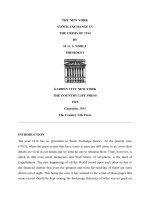Mastering The Essentials of Sales_3 pdf
Bạn đang xem bản rút gọn của tài liệu. Xem và tải ngay bản đầy đủ của tài liệu tại đây (255.08 KB, 23 trang )
that they don’t realize their
frustrations turn into flaws,
like a diamond’s natural inclu-
sions, that lower its market
value.
What makes a good man-
ager is similar to what makes
a good diamond. While three of the four C’s that make up
the value of a diamond are dictated by nature, humans con-
trol only one—the cut. The goal of the diamond cutter is to
maximize the amount of light reflected, not to divert or ob-
scure it. The goal of the manager is no different.
MASTERING THE ESSENTIALS OF SALES
39
REMINDER
If you want to shine
like a star you must
bring sunshine
to others.
This page intentionally left blank
41
M
any sales managers believe that solid product knowl-
edge is the foundation of sales success. To sell well, the
theory goes, salespeople need to develop a detailed knowl-
edge of their product, their markets, and their customers.
It’s a useful theory, but if knowledge alone were enough to
succeed in selling, engineers would be the best salespeople.
And they aren’t. Many sales trainers believe that to suc-
ceed in sales, salespeople need more than knowledge: They
need to develop professional skills such as prospecting skills,
listening skills, presentation skills, negotiation skills, clos-
ing skills, and follow-up skills. It’s true. Professional skills
help close more sales. But experience tells us that there are
many salespeople who are very knowledgeable and highly
THE TRIANGLE OF
SALES SUCCESS
10
Copyright © 2006 by Gerhard Gschwandtner. Click here for terms of use.
skilled yet never break sales
records.
If knowledge and skills to-
gether still are not enough to
create success in selling, what’s
missing?
Motivation is the third leg
in the triangle of success. It is
the desire to win, the ability to bounce back after a setback,
and the ability to maintain a positive outlook in the face of
adversity.
The goal of a successful sales manager is to help each
salesperson on the team to expand the triangle of success.
If you are a sales manager, think of your salespeople.
How would you rate them on a scale from one to ten, with
ten being the highest level of knowledge, skills, and moti-
vation? Are your salespeople threes, fives, or tens?
In the ideal situation, all salespeople would be tens. Ide-
ally, they are all well-trained, knowledgeable, and moti-
vated. In reality, many of them don’t keep up with product
knowledge. In reality, many may use skills and techniques
that are outdated, wondering why they don’t get better re-
sults. In reality, many may boast that they are bent on win-
ning, yet in private they admit feeling overwhelmed to the
point that they are unable to put in an eight-hour day.
After a sober reality check, let’s take a look at the fu-
ture. If your salespeople are fives today, and they were fives
last year, how do you expect them to increase sales next
year? If your salespeople are average, your sales results are
likely to remain average.
MASTERING THE ESSENTIALS OF SALES
42
SUCCESS PRINCIPLE
Knowledge creates
confidence, skill creates
opportunities, and
motivation creates
winners.
Now, let’s take a look at your prospects. Would you call
them average or above average in terms of education,
skills, and motivation? If your salespeople are calling on
high-level decision makers who control important budgets,
then these clients are tens, not fives. What will happen
when a salesperson that you know is a five calls on a cus-
tomer that you know is a ten? Right! No sale. Tens like to
buy from tens. Just getting an appointment with a ten
seems like an insurmountable challenge to a five.
Finally, take a look at your competition. What will hap-
pen to your market share if your competitors train, edu-
cate, and motivate their salespeople to be tens? Guess who
will be winning clients and who will be losing clients? The
answer is obvious: A sales force with more knowledge, with
better skills, and with a higher level of motivation is des-
tined to win.
MASTERING THE ESSENTIALS OF SALES
43
This page intentionally left blank
45
G
eneral Norman Schwarzkopf once told Selling Power
that people come to work to win, not to lose. Yet, for
some reason, many teams fail. Why? These teams have
been unable to assemble the foundation that supports suc-
cess. Here are eight key building blocks.
1. Vision. Successful teams develop a vision based on a
realistic assessment of the opportunity in the mar-
ketplace and a down-to-earth appraisal of the team’s
true capabilities. The purpose of the team vision is to
stretch team capabilities, to energize the team’s
dream, and to boost individual performance.
TEAMWORK MAKES
DREAMS WORK
11
Copyright © 2006 by Gerhard Gschwandtner. Click here for terms of use.
2. Commitment. Basketball coach Pat Riley once said,
“The disease of me prevents the evolution of us.” A
healthy team ego emerges when all team members
are 100 percent committed to helping each other
win.
3. Communication. Teams need a fast and efficient
communication system to function properly. The best
teams in today’s business environment aggressively
pursue knowledge and share every bit of information
fast, freely, and enthusiastically. The best business
teams use the best communications technology.
4. Interdependence. At the core of a winning team is
trust. Smart teams learn that all team members are
part of an ecosystem that is capable of sustaining
everyone. Over time, teams realize that each team
member has the capacity to contaminate the entire
system, but also, that each team member has the
ability to cleanse and restore the ecosystem.
5. Creativity. To win, every team must solve problems
and overcome tough challenges. Studies show that a
good team is a lot smarter than any individual
alone—providing the team has a methodology for
tapping individual creativity.
6. Diversity. Teams survive on similarity, but they
thrive on diversity. Diversity
challenges team members to
drop their “diversity bias” and
open their eyes to a richer
database of experiences and
approaches to problem solv-
ing.
MASTERING THE ESSENTIALS OF SALES
46
ACTION TIP
If you want to be part of
a great team, leave your
ego at the door and help
others achieve more.
7. Care. Coach Lou Holtz once told his team, “Believe
that if enough people care we’ll win.” The secret to
winning for Holtz boils down to a three-part formula:
Do right, do your best, and care about others.
8. Choice. Every team member has a choice: to play to
win as a team or to lose individually. Not every team
member can make that choice, and not every team
member can win. Building and maintaining a win-
ning team spirit is a formidable challenge. Tough
competition mandates that we stand united, tough,
and committed, or risk failure.
MASTERING THE ESSENTIALS OF SALES
47
This page intentionally left blank
49
A
recent Gallup poll on public trust shows that we don’t
trust anyone 100 percent. Americans give the military
only a 64 percent trust rating; the police earned 58 percent;
and religion is in third place with a 57 percent trust factor.
Among the professions, the highest trust ratings went to
pharmacists, individual clergy, doctors, dentists, engineers,
and college professors. The survey also stated that clergy
are trusted more than twice as much as journalists—who,
in turn, are twice as trusted as lawmakers. While a code of
ethics often specifies what people ought not to do, the cre-
ation of trust depends on what people actually do.
To measure the credibility gap in corporate America,
the Ethics Officer Association and the American Society of
HOW DO YOU CREATE TRUST?
12
Copyright © 2006 by Gerhard Gschwandtner. Click here for terms of use.
Chartered Life Underwriters & Chartered Financial Con-
sultants sponsored a survey of 1,324 randomly selected
workers, managers, and executives in a variety of indus-
tries. The survey found that 48 percent of the respondents
admitted to taking unethical or illegal actions in the past
year. Fifty-seven percent said that they felt more pressure
to be unethical than they had felt five years ago.
In a recent anonymous survey of 255 IS professionals in
Computerworld magazine, 47 percent admitted to copying
commercial software without authorization. Yet 78 percent
of all respondents agreed that it should never be done.
Trustworthiness is the backbone of good management.
Effective leaders can build trust by encouraging people to
rally behind the idea that their work should be dedicated to
the common good.
To survive and grow, a company needs to create trust-
worthiness in the eyes of stockholders, employees, and cus-
tomers. Sales leaders can influence the level of trust
between salespeople and customers, between back office and
sales office, and between sales
team and management. Creat-
ing trust is a far greater chal-
lenge than developing a new
marketing campaign. Trust de-
mands that the heart, mind,
and soul are involved in a full
circle that connects all rela-
tionships, internal and exter-
nal. Winning companies forge a
supply chain of trust that links
their company with the cus-
MASTERING THE ESSENTIALS OF SALES
50
REMINDER
To make a buying
decision, a customer has
to make a leap of faith.
Successful salespeople
create a safety net
called trust. Trust
helps your customers
take that leap in
complete confidence.
tomer organization. Winning companies know that trust-
worthiness is equally important to everyone—the employee,
the manager, the supplier, the customer, the stockholder, and
the community at large.
Trust is not a question of walking the talk from 9 to 5; it
demands vigilance around the clock. Trust isn’t what we do
on American soil, under American law; but it’s what we do
around the globe. Trust isn’t what we say when someone is
listening; trust depends on what we do when nobody is
watching. Trust is a matter of 360 degrees.
MASTERING THE ESSENTIALS OF SALES
51
This page intentionally left blank
53
I
recently visited with a VP of sales of a successful com-
pany who is a former U.S. Marine. When he introduced
me to his staff, I noticed that many of his top sales produc-
ers had been Marines or graduates of the Naval Academy.
When I asked him about his recruiting strategy he said,
“These recruits have a common value system, they under-
stand what it means to have a mission, and they take pride
in everything they do.” While former Marine Corps mem-
bers often run successful sales organizations, experienced
business executives are frequently unaware of the motiva-
tional master plan that runs America’s finest military or-
ganization.
HOW MARINES MOTIVATE
THE FRONT LINE
13
Copyright © 2006 by Gerhard Gschwandtner. Click here for terms of use.
Don Carrison, a former Marine and co-author of the
book Semper Fi: Business Leadership the Marine Corps
Way, says sales leaders can learn a lot from the Marine
Corps’ model about how to recruit the best people, design
better training, develop teamwork, inspire loyalty, and
achieve victory.
Here are some of the key components of the Marine
Corps’ blueprint for success:
1. Recruiting. Marines send out their top performers
to recruit the best people. These experienced officers
display a missionary zeal, and they personify the val-
ues and pride of a Marine. Carrison suggests that
sales managers send out star performers who em-
body the values of the organization to serve as role
models for new recruits.
2. Training. Marines spend 12 weeks in basic train-
ing. When the training gets tough, drill sergeants
often quote the old saying, “The more you sweat in
peace, the less you bleed in war.” Boot camp is not de-
signed to weed out certain people, but to cultivate
everybody. While corporate America fires those who
don’t perform up to standard, new Marines practice
until everybody graduates.
3. Leadership. Marine officers lead by example. If a
leader asks a platoon to climb a 100-foot wall, he will
be the first one to start the climb. Of all military serv-
ices, the Marine Corp has the highest casualty rate
among officers. In corporate America, the best sales
managers are not the ones who hide behind their
desks, but those who go out to see the toughest cus-
MASTERING THE ESSENTIALS OF SALES
54
tomers with their front-
line people.
4. Commitment. The Ma-
rine Corps’ credo is “Do
or die.” Carrison says
that you have to be care-
ful what you ask a Ma-
rine to do because he’ll
die trying. Marines in
action show how much a
highly committed team
can accomplish. What if salespeople adopted such
high standards for conquering new territories or in-
troducing new products?
5. Loyalty to the troops. While corporate America
often tells employees that they are replaceable,
Marines are told that they are irreplaceable. They
know that the entire country and their fellow Marines
depend on them. It’s natural for a Marine to say, “I
love my Marine Corps.” How many salespeople say, “I
love my company.” More and more companies are
studying the Marine Corps’ model for motivation. As
a result, their sales teams take more pride in their
product and in their companies. Imagine the possi-
bilities. Imagine every salesperson in your company
as proud as a Marine. Imagine how many competi-
tive battles you’d win. Every year, thousands of loyal
and highly trained Marines retire: Why not deploy
their talents to win more sales?
MASTERING THE ESSENTIALS OF SALES
55
ACTION TIP
Develop a credo that
reflects your core beliefs
in dealing with
customers. Think about
what would happen to
your sales if you served
your customers as loyally
as Marines serve
our country.
This page intentionally left blank
57
A
lthough there are more than 1,200 books on the subject
of success, very few deal with the subject of consistent
success. What makes companies like Kellogg, Tiffany, or
UPS grow decade after decade, while 80 percent of all new
businesses fold within five years? Why do some CEOs stay
at the top of their corporations for two decades while others
get axed after a few years? Why do some salespeople stay
in the top 10 percent year after year while others never
reach the top half? Is it destiny that shapes a fixed star and
fate that creates a shooting star?
Let’s look at what makes businesses consistently suc-
cessful. Kellogg’s founders established a strong value system
HOW TO ACHIEVE
CONSISTENT SUCCESS
14
Copyright © 2006 by Gerhard Gschwandtner. Click here for terms of use.
based on delivering healthy
and wholesome products to
their customers. The Kellogg
philosophy was simple, it was
straightforward, and it cap-
tured the imagination of gener-
ations of CEOs. As a result, the
structure of Kellogg grew con-
sistently while the operation
improved consistently, along
with sales and profits. The story
of UPS follows a similar pat-
tern, and Tiffany has been a jewel of a company since 1837.
Here is a short list of attributes of consistently success-
ful companies and their visionary leaders:
1. Strong core values are the starting place
where all success begins. We all can choose a phi-
losophy of how to live, work, and succeed. Our chances
for success will improve if we consciously define
what we want to get out of life and what we plan to
give back to society.
2. Develop crystal-clear focus on a life goal or
mission. Successful people know that new informa-
tion tends to erode existing knowledge, and old
knowledge often interferes with understanding new
information. Keep your goals safe from erosion over
time. Create a safe place in your mind where all
personal-development ideas converge.
3. Become the architect of a consistently success-
ful life. Consistently successful people are at the
MASTERING THE ESSENTIALS OF SALES
58
SUCCESS PRINCIPLE
In the universe of
success, there are
shooting stars and
shining stars. While
shooting stars burn their
substance, shining stars
share their radiance
forever with the
entire universe.
same time the builders and the architects of their
lives. Architects create blueprints; consistently suc-
cessful people develop life-design strategies.
4. Manage career decisions wisely. All careers in-
volve a series of takeoffs and landings. The past 10
years have turned into a decade of downsizing when
middle managers have experienced rough landings.
Individuals can no longer depend on organizations to
provide consistent opportunities for success. People
have to think about creating their own structure and
design their lives around their own needs, talents, and
capabilities. You may find more success by digging
deeper right where you are than by taking your spade
across the street.
5. Be more persistent and become more consis-
tent. There is a difference between having a good
time and having a good life. A lucky lottery ticket can
make you a millionaire overnight, but it won’t make
you a consistently successful person. Think of a con-
sistently successful life as a near perfect golf swing.
Consistently successful golfers practice every day,
year after year, decade after decade. Daily practice
ensures your membership in the exclusive club of
consistently successful people.
Think about your current level of success. How
can you expand on it? How can you make your suc-
cess last longer? How can you avoid downward career
trends? Do you have a life-design strategy? Consider
your possibilities. It is your life.
MASTERING THE ESSENTIALS OF SALES
59
This page intentionally left blank
61
A
recent study reports that profits at America’s top 1,000
companies fell dramatically during the past year. This
drop has turned into unlucky news for millions of execu-
tives across the country. Here is a sampling of changes as a
result of this decline:
1. Nervous investors are demanding that CEOs no
longer assume the job of a chairman and are urging
corporate boards to assign the chairman’s role to an
outsider. Lower profits mean lower job security for
CEOs, lower compensation and fewer perks for top
executives.
AN URGENT REMINDER—
THINK PROFITS!
15
Copyright © 2006 by Gerhard Gschwandtner. Click here for terms of use.









